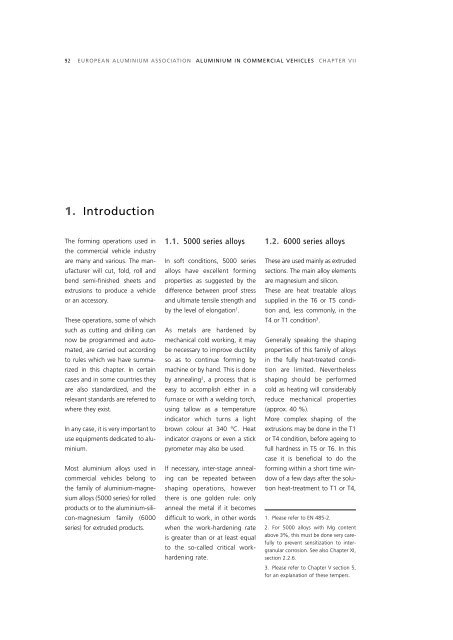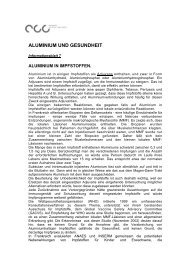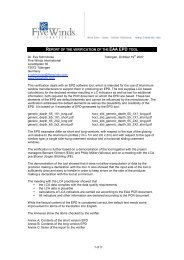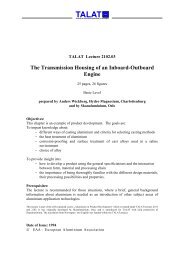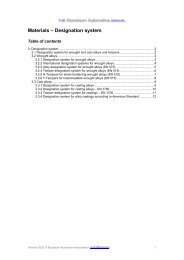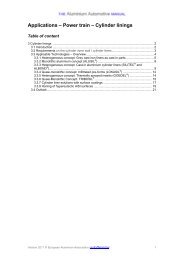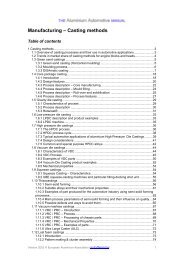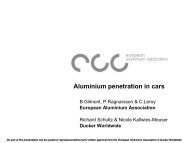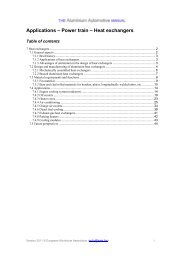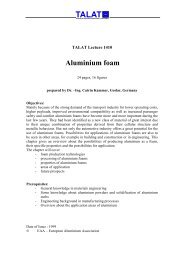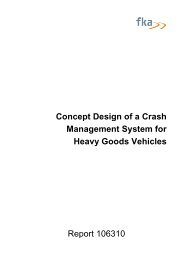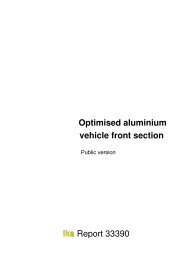aluminium in commercial vehicles - European Aluminium Association
aluminium in commercial vehicles - European Aluminium Association
aluminium in commercial vehicles - European Aluminium Association
You also want an ePaper? Increase the reach of your titles
YUMPU automatically turns print PDFs into web optimized ePapers that Google loves.
92 EUROPEAN ALUMINIUM ASSOCIATION ALUMINIUM IN COMMERCIAL VEHICLES CHAPTER VII<br />
1. Introduction<br />
The form<strong>in</strong>g operations used <strong>in</strong><br />
the <strong>commercial</strong> vehicle <strong>in</strong>dustry<br />
are many and various. The manufacturer<br />
will cut, fold, roll and<br />
bend semi-f<strong>in</strong>ished sheets and<br />
extrusions to produce a vehicle<br />
or an accessory.<br />
These operations, some of which<br />
such as cutt<strong>in</strong>g and drill<strong>in</strong>g can<br />
now be programmed and automated,<br />
are carried out accord<strong>in</strong>g<br />
to rules which we have summarized<br />
<strong>in</strong> this chapter. In certa<strong>in</strong><br />
cases and <strong>in</strong> some countries they<br />
are also standardized, and the<br />
relevant standards are referred to<br />
where they exist.<br />
In any case, it is very important to<br />
use equipments dedicated to <strong>alum<strong>in</strong>ium</strong>.<br />
Most <strong>alum<strong>in</strong>ium</strong> alloys used <strong>in</strong><br />
<strong>commercial</strong> <strong>vehicles</strong> belong to<br />
the family of <strong>alum<strong>in</strong>ium</strong>-magnesium<br />
alloys (5000 series) for rolled<br />
products or to the <strong>alum<strong>in</strong>ium</strong>-silicon-magnesium<br />
family (6000<br />
series) for extruded products.<br />
1.1. 5000 series alloys<br />
In soft conditions, 5000 series<br />
alloys have excellent form<strong>in</strong>g<br />
properties as suggested by the<br />
difference between proof stress<br />
and ultimate tensile strength and<br />
by the level of elongation1 .<br />
As metals are hardened by<br />
mechanical cold work<strong>in</strong>g, it may<br />
be necessary to improve ductility<br />
so as to cont<strong>in</strong>ue form<strong>in</strong>g by<br />
mach<strong>in</strong>e or by hand. This is done<br />
by anneal<strong>in</strong>g2 , a process that is<br />
easy to accomplish either <strong>in</strong> a<br />
furnace or with a weld<strong>in</strong>g torch,<br />
us<strong>in</strong>g tallow as a temperature<br />
<strong>in</strong>dicator which turns a light<br />
brown colour at 340 °C. Heat<br />
<strong>in</strong>dicator crayons or even a stick<br />
pyrometer may also be used.<br />
If necessary, <strong>in</strong>ter-stage anneal<strong>in</strong>g<br />
can be repeated between<br />
shap<strong>in</strong>g operations, however<br />
there is one golden rule: only<br />
anneal the metal if it becomes<br />
difficult to work, <strong>in</strong> other words<br />
when the work-harden<strong>in</strong>g rate<br />
is greater than or at least equal<br />
to the so-called critical workharden<strong>in</strong>g<br />
rate.<br />
1.2. 6000 series alloys<br />
These are used ma<strong>in</strong>ly as extruded<br />
sections. The ma<strong>in</strong> alloy elements<br />
are magnesium and silicon.<br />
These are heat treatable alloys<br />
supplied <strong>in</strong> the T6 or T5 condition<br />
and, less commonly, <strong>in</strong> the<br />
T4 or T1 condition3 .<br />
Generally speak<strong>in</strong>g the shap<strong>in</strong>g<br />
properties of this family of alloys<br />
<strong>in</strong> the fully heat-treated condition<br />
are limited. Nevertheless<br />
shap<strong>in</strong>g should be performed<br />
cold as heat<strong>in</strong>g will considerably<br />
reduce mechanical properties<br />
(approx. 40 %).<br />
More complex shap<strong>in</strong>g of the<br />
extrusions may be done <strong>in</strong> the T1<br />
or T4 condition, before age<strong>in</strong>g to<br />
full hardness <strong>in</strong> T5 or T6. In this<br />
case it is beneficial to do the<br />
form<strong>in</strong>g with<strong>in</strong> a short time w<strong>in</strong>dow<br />
of a few days after the solution<br />
heat-treatment to T1 or T4,<br />
1. Please refer to EN 485-2.<br />
2. For 5000 alloys with Mg content<br />
above 3%, this must be done very carefully<br />
to prevent sensitization to <strong>in</strong>tergranular<br />
corrosion. See also Chapter XI,<br />
section 2.2.6.<br />
3. Please refer to Chapter V section 5,<br />
for an explanation of these tempers.


